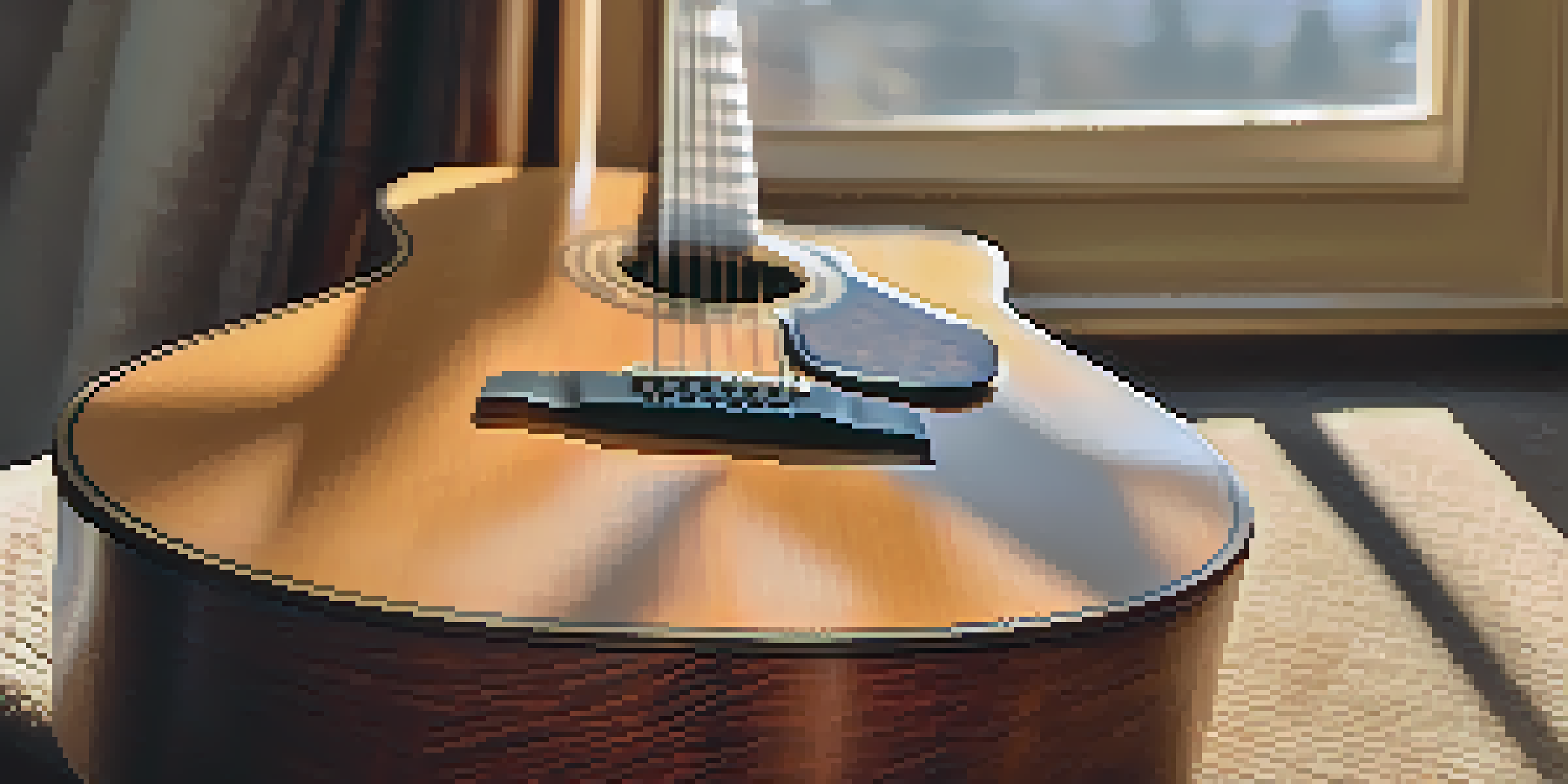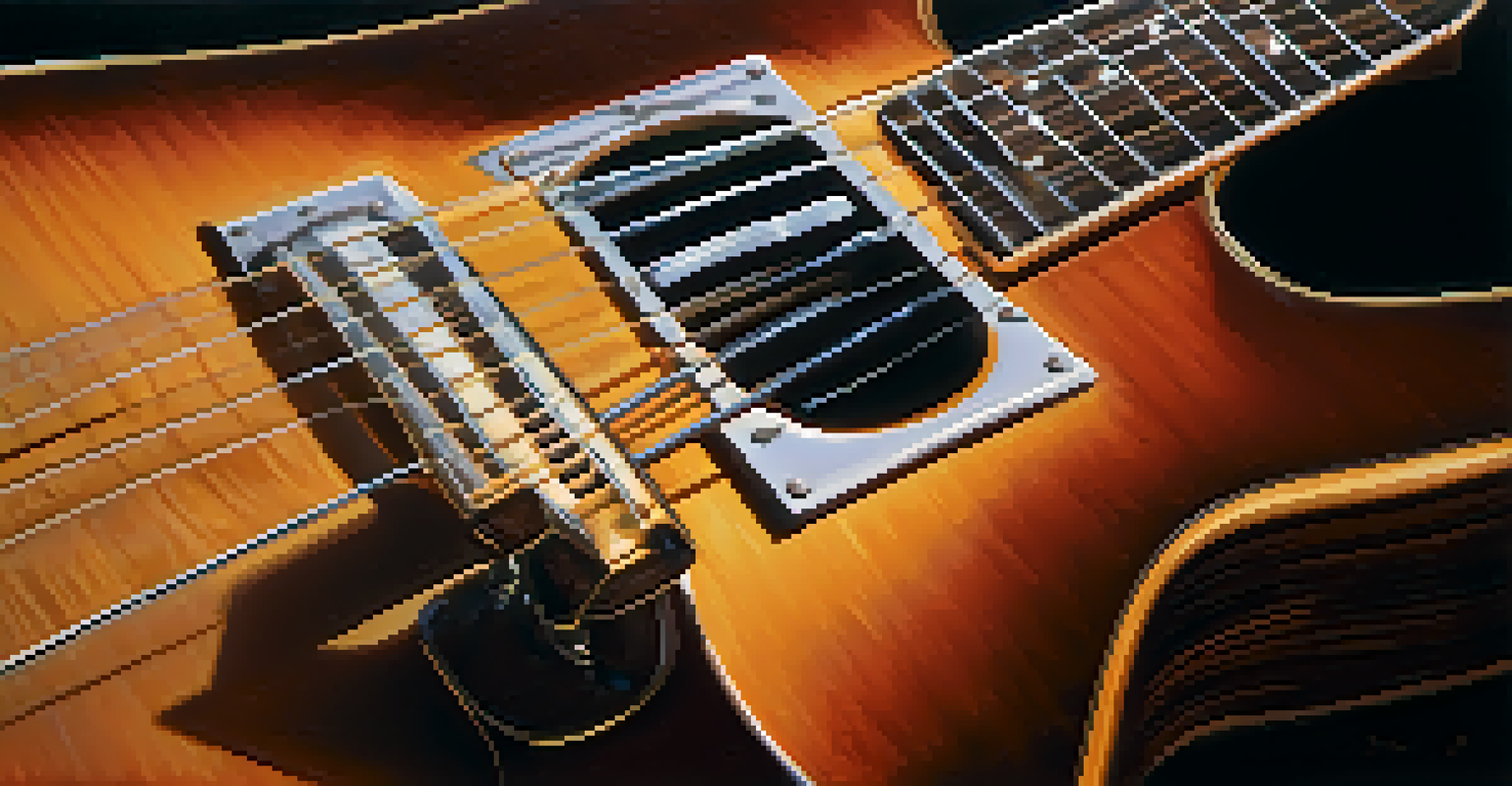Understanding the Basics of Guitar Construction Techniques

The Importance of Guitar Construction in Sound Quality
When it comes to guitars, the construction techniques used play a crucial role in determining the sound quality. A well-constructed guitar will resonate better, producing a fuller, richer tone. On the flip side, poor construction can lead to sound issues, making it vital for players to understand these basics.
The guitar is a miniature orchestra in itself.
Think of guitar construction like building a house: if the foundation is weak, the entire structure will suffer. Similarly, elements like wood selection and joinery affect not only the aesthetics but also the acoustic properties of the instrument. This is why musicians often gravitate towards brands known for their craftsmanship.
By grasping the fundamentals of guitar construction, players can make informed decisions when purchasing or even building their own instruments. This knowledge not only enhances their playing experience but also deepens their appreciation for the craft behind their beloved guitars.
Key Materials Used in Guitar Construction
The materials chosen for guitar construction significantly impact both durability and sound. Common woods like mahogany, spruce, and rosewood are favored for their unique tonal characteristics. For example, spruce is often used for the top of acoustic guitars because of its excellent sound projection.

Different woods can produce a variety of sounds; mahogany tends to offer a warm, mellow tone while rosewood adds brightness and clarity. Understanding these materials helps musicians select a guitar that fits their style, whether they're strumming chords or playing intricate solos.
Guitar Construction Impacts Sound
The techniques and materials used in guitar construction play a vital role in determining the instrument's sound quality.
Additionally, the choice of materials extends beyond wood; metals used in hardware and strings also influence the overall sound. Knowledge of these materials empowers players to choose instruments that truly resonate with their musical identity.
The Role of Guitar Body Shape in Sound Production
The shape of a guitar's body is not just about aesthetics; it significantly affects how sound is produced and projected. Acoustic guitars, for instance, come in various shapes like dreadnought, concert, and parlor, each designed to create different tonal qualities. A dreadnought shape typically provides a powerful sound with ample bass response.
A guitar is more than just a collection of wood and strings. It's a gateway to creativity and expression.
Moreover, the size of the body can influence the volume and resonance of the instrument. Larger bodies can produce a louder sound, while smaller ones may yield a more intimate tone, suitable for fingerpicking styles. This aspect of guitar construction is crucial for players to consider based on their musical preferences.
Ultimately, understanding body shapes allows musicians to select a guitar that complements their playing style and the genres they enjoy. Whether you prefer the booming sound of a dreadnought or the crispness of a smaller body, the right choice enhances the overall playing experience.
Exploring Different Neck Types and Their Impact
The neck of a guitar is often referred to as its backbone, and for good reason. It plays a vital role in playability and comfort, affecting how easily a musician can navigate the fretboard. Common neck types include bolt-on, set neck, and neck-through, each offering unique advantages.
For example, a bolt-on neck allows for easier maintenance and replacement, while a set neck typically provides better sustain due to a more solid connection to the body. Understanding these neck types helps players choose an instrument that not only fits their playing style but also feels comfortable in their hands.
Body Shape Influences Tone
The shape of a guitar's body significantly affects its sound production and projection, determining how well it complements various playing styles.
Additionally, the width and profile of the neck can drastically affect a player's technique. A wider neck might be preferred for fingerstyle playing, while a slimmer neck can benefit those who play fast solos. Knowing these details can enhance a guitarist's overall performance.
The Importance of Fretboard Material and Radius
The fretboard material and its radius are crucial elements that influence how a guitar feels to play. Common materials include rosewood and maple, each providing a different tactile experience. Rosewood offers a warmer feel and a softer touch, while maple tends to be brighter and snappier.
The radius of the fretboard, which refers to the curvature across its width, also affects playability. A flatter radius can be beneficial for bending notes and fast playing, while a rounder radius may be more comfortable for chord strumming. Understanding these characteristics helps players tailor their instrument to their preferred playing style.
Ultimately, the choice of fretboard material and radius can make a significant difference in performance. By exploring these options, musicians can find a guitar that feels just right, allowing them to focus on what truly matters: making music.
Understanding the Role of Bracing in Acoustic Guitars
Bracing refers to the internal support structure of acoustic guitars, playing a critical role in shaping sound and ensuring stability. Different bracing patterns, such as X-bracing or fan bracing, affect how the guitar vibrates and resonates. X-bracing, for example, is common for its ability to enhance volume and projection.
The choice of bracing can also influence the overall tonal quality of the guitar. A well-braced guitar will have a balanced sound across its range, while poor bracing may lead to dead spots or uneven tones. Understanding these intricacies helps musicians appreciate the craftsmanship behind their instruments.
Fretboard Choices Matter
The material and radius of a guitar's fretboard can greatly influence playability and comfort, impacting a musician's performance.
By learning about bracing, players can make more informed choices when selecting an acoustic guitar. Whether they prioritize volume, tonal richness, or playability, knowledge of bracing techniques allows them to find an instrument that meets their musical needs.
Finishing Techniques and Their Effects on Guitars
Finishing techniques are the final touch in guitar construction, impacting both appearance and sound. Common finishes include lacquer, polyurethane, and oil, each offering different levels of protection and aesthetic appeal. For instance, lacquer finishes provide a high-gloss look but can be less durable than polyurethane.
Beyond aesthetics, the finish can affect how the wood vibrates and resonates. A thicker finish may dampen vibrations, potentially muting the sound, while a thinner finish allows for more natural resonance. Understanding these effects helps musicians appreciate the nuances of their instrument's tone.

Ultimately, the finish of a guitar can significantly influence its overall character. By exploring different finishing techniques, players can find a guitar that not only looks great but also sounds incredible, enhancing their musical experience.